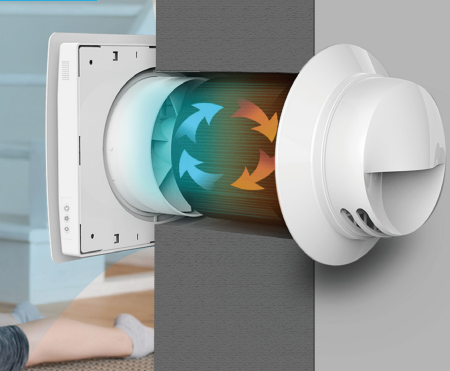How HRV Stabilizes Indoor Climate
Wiki Article
The All-Inclusive Overview to the Uses of Heat Recovery Ventilation in Modern Buildings
Heat Recovery Ventilation (HRV) systems stand for a substantial improvement in building modern technology (HRV Heat Recovery Ventilation). They supply a method for trading stale indoor air with fresh exterior air while reducing energy loss. This technique not only boosts indoor air top quality however additionally adds to power effectiveness in both domestic and business buildings. Recognizing the different applications and benefits of HRV can disclose its important role in modern style and sustainability efforts. The implications of this technology are worth discovering additionallyRecognizing Heat Recovery Ventilation Solutions

Although many contemporary buildings focus on power effectiveness, recognizing warmth recovery ventilation (HRV) systems is essential for optimizing indoor air high quality and lowering energy usage. HRV systems function by transferring heat from stale indoor air to incoming fresh air, effectively maintaining comfortable indoor temperatures while minimizing energy loss. These systems consist of a warm exchanger, fans, and ductwork that help with the blood circulation of air. During winter season, HRV devices record and reuse warm from the outgoing air, while in summer season, they can aid cool inbound air. By continuously trading air, HRV systems likewise decrease humidity and the concentration of indoor pollutants. Correct installation and maintenance of HRV systems are necessary for their performance and effectiveness in enhancing overall structure efficiency and convenience.
Advantages of Heat Recovery Ventilation
Heat recovery ventilation systems use many advantages that improve both power effectiveness and interior air high quality in contemporary buildings. By recording and recycling energy from exhaust air, these systems considerably decrease heating and air conditioning costs, leading to reduced energy consumption. They keep a consistent circulation of fresh outside air, decreasing the risk of indoor air pollutants and irritants. This continuous exchange helps regulate moisture levels, stopping mold growth and making certain a healthier living atmosphere. Furthermore, HRV systems contribute to sustainability goals by decreasing overall carbon footprints. Their capacity to enhance ventilation without compromising thermal comfort makes them a beneficial addition to modern building style, promoting both financial and ecological benefits.Applications of HRV in Residential Structures
As property owners significantly prioritize power performance and indoor air top quality, the applications of heat recuperation ventilation (HRV) systems in household buildings have actually become a lot more common. HRV systems are specifically advantageous in securely secured homes, where keeping fresh air circulation is vital for protecting against moisture accumulation and interior toxins. They effectively transfer warm from outbound stagnant air to inbound fresh visit here air, reducing energy expenses linked with cooling and heating. Additionally, HRVs can improve convenience levels by regulating moisture and temperature level. They are additionally versatile for numerous residential designs, including single-family homes and multi-unit buildings. In general, incorporating HRV systems sustains lasting living practices while guaranteeing a healthier indoor environment for residents.HRV in Commercial and Industrial Settings
In business and commercial settings, the execution of warmth healing air flow (HRV) systems has ended up being increasingly crucial for optimizing energy efficiency and maintaining air high quality. These systems successfully move warm from exhaust air to inbound fresh air, minimizing the requirement for added home heating or air conditioning. This not only reduces energy costs but additionally contributes to sustainability efforts. Industries such as manufacturing, warehousing, and office complex profit considerably from HRV systems, as they internet help control temperature and moisture degrees, guaranteeing a comfortable and effective setting. HRV systems help in eliminating contaminants and excess wetness, boosting interior air quality. As guidelines around air high quality become more stringent, the adoption of HRV modern technology is likely to grow, making it a vital element of modern industrial and commercial facilities.Future Trends in Heat Recovery Ventilation Modern Technology

Frequently Asked Concerns
How Does Heat Recovery Ventilation Effect Indoor Air High Quality?
Heat recovery ventilation considerably boosts interior air high quality by continuously exchanging stagnant interior air with fresh exterior air while recuperating energy. This process minimizes contaminants, preserves optimal humidity degrees, and ensures a much healthier atmosphere for passengers.Can HRV Solutions Be Mounted in Existing Structures?
HRV systems can indeed be installed in existing structures. Retrofitting may require modifications to ductwork and ventilation layouts, however it significantly improves energy efficiency and indoor air quality, making it a practical option for older frameworks.What Maintenance Is Needed for HRV Equipments?

Are There Details Climates Where HRV Is Extra Efficient?
Heat recovery ventilation systems are specifically reliable in environments with considerable temperature distinctions in between seasons. These systems maximize energy efficiency by recuperating heat from exhaust air, making them ideal for both chilly and moderately cozy environments.Just How Do HRV Solutions Affect Power Expenses?

Report this wiki page